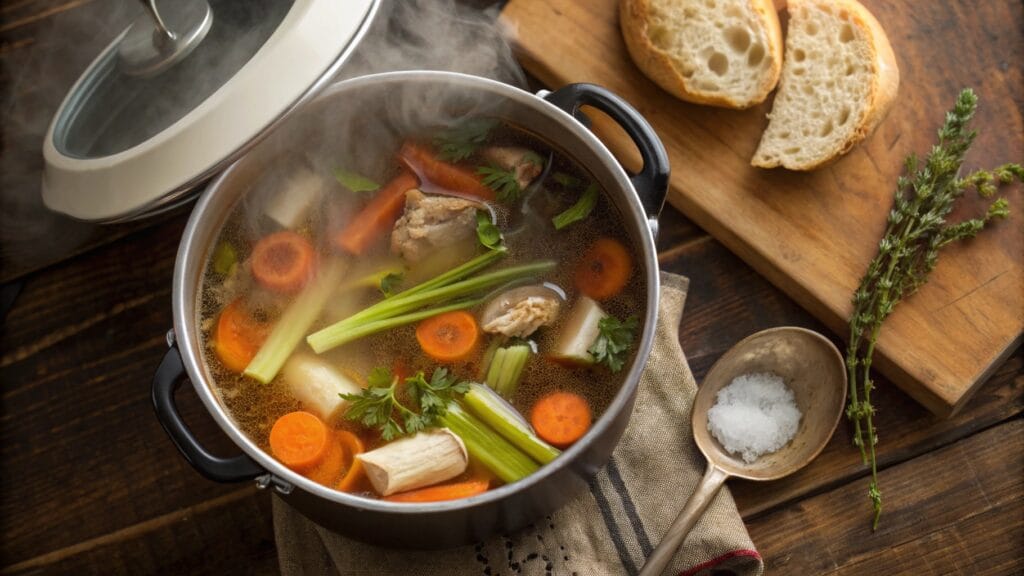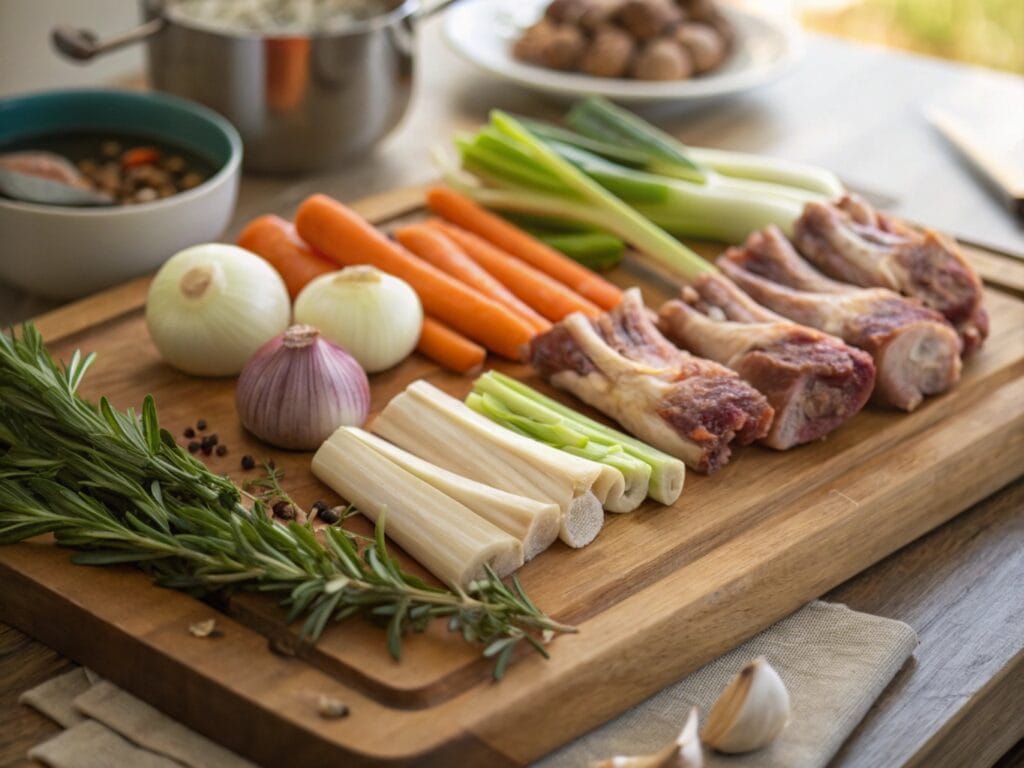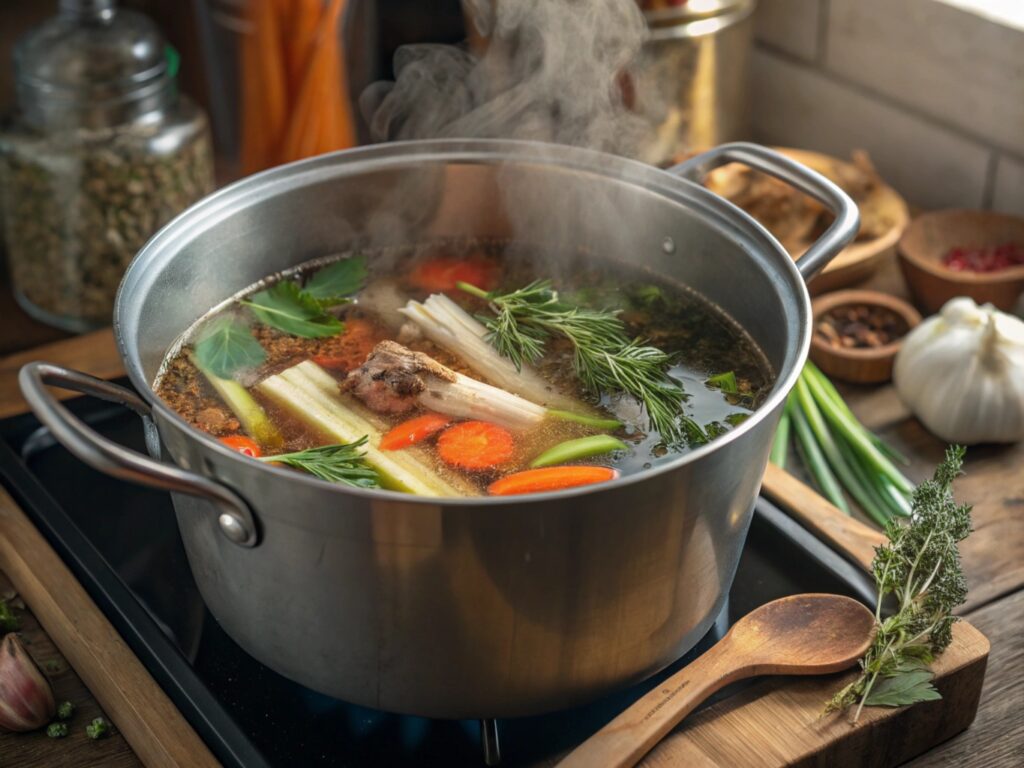Soup Bones are the unsung heroes of flavorful broths and hearty soups, packed with nutrients and bursting with possibilities. Whether you’re an experienced chef or a kitchen newbie, learning how to use these bones can transform your cooking game. This guide explores the different types of bones, their health benefits, cooking methods, and delicious recipes. Let’s uncover why these humble bones deserve a prime spot in your pantry.

Introduction to Soup Bones
What Are Soup Bones?
Simply put, these bones are the foundation for creating rich, flavorful broths. Typically from beef, chicken, pork, or fish, they are used to extract nutrients, collagen, and taste. Often sourced from less commonly consumed parts of the animal, such as joints, shanks, or marrow-filled cuts, they are culinary gold when prepared properly.
In traditional cooking, bones were prized for their ability to create dishes with depth and complexity. From beefy consommés to delicate fish stocks, they have played an integral role across cuisines and cultures.
Brief History and Culinary Uses
Historically, using bones for broth was a method of waste reduction—making the most out of every part of the animal. But beyond frugality, bones bring essential minerals and gelatins to the table, which make soups not just comforting but also nutritious.
Today, these bones are celebrated for their versatility. They form the base for broths, stews, gravies, and sauces. Whether you’re whipping up a classic French bouillabaisse or a simple chicken noodle soup, they infuse dishes with unparalleled flavor and texture.
Types of Soup Bones and Their Best Uses

Beef Bones for Broths and Soups
When it comes to crafting a robust broth, beef bones are king. Cuts like oxtail, marrow bones, and knuckles are packed with collagen and rich marrow that melt into the liquid during cooking. This not only thickens the broth but also gives it a luxurious mouthfeel. Use beef bones for hearty soups like French onion or Vietnamese pho, where a strong base elevates the dish’s flavors.
For maximum flavor, roast the bones beforehand. This simple step caramelizes the natural sugars, adding depth and complexity to your broth.
Chicken Bones: The Backbone of Light Soups
If you’re looking for something lighter, chicken bones are your best bet. Leftover carcasses, wings, and drumsticks make excellent soup bases. The collagen in chicken bones creates a silky broth, perfect for chicken noodle soup or a comforting bowl of chicken and dumplings.
Unlike beef, chicken broth develops its flavor more quickly, making it ideal for weeknight meals. Adding aromatic vegetables like celery, carrots, and onions enhances its natural sweetness.
Lamb, Pork, and Fish Bones in Various Cuisines
Don’t stop at beef and chicken! Lamb bones offer a unique, earthy flavor that pairs well with spices like cinnamon and cumin, making them a favorite in Middle Eastern and North African dishes. Pork bones, often used in Asian soups like ramen or tonkotsu, provide a creamy texture and subtle sweetness.
For a lighter and quicker alternative, fish bones shine in seafood stews and bisques. Be sure to simmer them gently to avoid bitterness, and add herbs like dill or parsley for a refreshing touch.
Vegetarian Alternatives to Traditional Soup Bones
Surprisingly, you don’t need meat to create a satisfying broth. For vegetarians, mushrooms, seaweed, and root vegetables mimic the depth of soup bones. Kombu (a type of seaweed) and shiitake mushrooms are packed with umami, giving vegetarian broths a rich and savory profile.
The Nutritional Benefits of Soup Bones
Collagen and Its Role in Health
One of the standout benefits of soup bones is their collagen content. As bones simmer, they release collagen, which turns into gelatin. This protein supports joint health, strengthens skin, and aids in digestion. Adding bone broth to your diet can keep your gut happy and your skin glowing!
Vitamins and Minerals in Bone Marrow
Bone marrow, found inside soup bones, is a treasure trove of nutrients. It contains essential vitamins like B12 and A, along with iron and zinc. These nutrients support your immune system, improve energy levels, and help maintain healthy blood cells. For anyone looking to boost their nutrition naturally, soup bones are an excellent choice.
How Soup Bones Support Gut and Skin Health
It’s no secret that soup bones are a favorite in gut-healing diets. The gelatin they release helps seal and repair the intestinal lining, which can alleviate conditions like leaky gut syndrome. Additionally, the amino acids in gelatin, such as glycine and proline, promote collagen production, improving skin elasticity and reducing wrinkles.
Sipping a cup of bone broth daily isn’t just comforting—it’s a simple way to nourish your body from the inside out.
How to Choose the Best Soup Bones
What to Look for in Quality Bones
Selecting the right soup bones can be the difference between a mediocre broth and a masterpiece. Look for bones with plenty of connective tissue and marrow, as these are rich in collagen and flavor. Joints, knuckles, and shank bones are prime options.
Freshness is key, so opt for bones that are sourced locally or from trusted suppliers. Avoid bones with an overly strong odor, as this may indicate they’re past their prime.
Differences Between Organic and Conventional Soup Bones
Organic bones often come from grass-fed or pasture-raised animals, making them a healthier choice. These are free from antibiotics and hormones, which is important for those prioritizing clean eating. While conventional bones are more budget-friendly, they may lack the same nutrient density.
Sustainability and Ethical Considerations in Bone Selection
Being mindful of where your soup bones come from is essential. Support farms and butchers that practice humane animal treatment and sustainable farming. Buying locally not only reduces your carbon footprint but also helps maintain quality and freshness.
For more delicious recipes, check out Tangle Recipes for inspiration.
Cooking Methods for Soup Bones

Basic Steps to Preparing Soup Bones
Preparation is everything when working with soup bones. Start by rinsing the bones to remove impurities. For richer flavor, roast them at 400°F until golden brown. This step caramelizes the natural sugars, creating a deeper, more robust broth.
Slow Cooking: Unlocking Deep Flavors
Slow cooking is a foolproof method for extracting every bit of goodness from bones. Combine them with vegetables like carrots, onions, and celery, then cover with water. Simmer on low for 8–12 hours, letting the magic happen. The long cooking time ensures maximum nutrient and collagen extraction.
Pressure Cooking for Quick and Nutrient-Rich Results
Pressed for time? A pressure cooker is your best friend. This method significantly reduces cooking time while still delivering a nutrient-rich broth. Add the bones, vegetables, and seasonings, then cook on high pressure for about 90 minutes.
Oven Roasting Bones for a Robust Broth
For an even deeper flavor, roast the bones before boiling them. This technique is especially great for beef and lamb, as it enhances the meaty undertones. After roasting, transfer the bones to a pot and simmer with aromatic herbs and vegetables.
These techniques ensure your broth will be both delicious and nourishing!
Delicious Recipes Using Soup Bones
Classic Beef Bone Broth Recipe
There’s nothing quite like the rich, savory flavor of homemade beef bone broth. Start by roasting soup bones (such as knuckles and marrow bones) at 400°F until golden brown. Transfer them to a large pot, add water, and toss in aromatic vegetables like onions, celery, and carrots. Season with bay leaves, garlic, and a splash of apple cider vinegar to help extract minerals. Simmer on low for 12–24 hours, skimming occasionally.
Use this broth as a base for soups, stews, or even gravies. The collagen in beef soup bones gives the broth a velvety texture, perfect for hearty dishes.
Chicken Bone Soup for the Soul
Chicken soup bones create a comforting, light broth that’s both flavorful and nutritious. Use leftover chicken carcasses or wings, along with garlic, ginger, and leeks for an aromatic twist. Cook for 6–8 hours on low heat, or use a pressure cooker for a quicker version.
This broth is an excellent base for chicken noodle soup, adding a nostalgic, homemade touch to your table.
Pork and Fish Broth Recipes with a Twist
Pork soup bones shine in dishes like ramen. Simmer them with soy sauce, miso, and green onions for a broth bursting with umami. For a lighter option, try fish bones. Combine with fennel, lemon, and parsley, simmering gently for 45 minutes to avoid bitterness.
Vegetarian Broths Inspired by Bone-Based Techniques
For vegetarians, mimic the richness of soup bones with shiitake mushrooms, kombu, and roasted vegetables. Add soy sauce or nutritional yeast for depth, and you’ll have a broth that rivals any bone-based version.
FAQs About Soup Bones
What Are the Best Bones for Making Broth?
The best soup bones vary depending on your dish. Beef knuckles and marrow bones create robust broths, while chicken wings and carcasses yield lighter flavors. Lamb and pork bones add earthy, rich tones, and fish bones are ideal for seafood dishes.
How Long Should You Cook Soup Bones?
Cooking time depends on the type of bones. Beef and pork bones benefit from long cooking times (12–24 hours), while chicken bones require 6–8 hours. Fish bones, being delicate, only need about 45 minutes. Adjust cooking times for pressure cookers to save time without sacrificing flavor.
Can You Reuse Soup Bones?
Yes! While soup bones lose some nutrients after the first boil, they can be reused for a lighter broth. Combine reused bones with fresh vegetables and herbs to refresh the flavor.
What Are Some Common Mistakes in Cooking with Soup Bones?
Avoid these pitfalls: not roasting bones before simmering, skipping vinegar to extract nutrients, and boiling too vigorously (it can make the broth cloudy). Simmer gently and skim foam for the clearest results.
Soup bones are versatile and forgiving—just follow these tips, and you’ll create broths worth savoring!
Popular Myths and Facts About Soup Bones
Do Soup Bones Really Improve Health?
There’s a lot of buzz around soup bones and their health benefits. Many claim that the collagen and minerals in bones support joint health, improve skin elasticity, and heal the gut. These benefits aren’t just myths—science backs them up! Collagen, for example, breaks down into amino acids like glycine, which aids digestion and reduces inflammation.
However, while soup bones are nutrient-rich, they’re not a cure-all. To get the most out of them, pair your broth with a balanced diet.
Is Bone Broth Overrated?
Some skeptics argue that bone broth is just trendy hype. But the truth is, soup bones have been a staple in global cuisines for centuries. From Asian stocks to French consommés, people have long relied on them for their flavor and nutrition.
While bone broth may not replace supplements or medical treatments, it’s a wholesome addition to your meals. Plus, it’s a sustainable way to use every part of the animal.
Can Everyone Consume Soup Bones Safely?
Most people can enjoy broth made from soup bones, but there are exceptions. Those with high uric acid levels or certain kidney issues should consult a doctor before consuming bone-based broths. Additionally, individuals with food sensitivities should monitor for reactions to additives or seasonings.
When sourced and prepared correctly, soup bones are a safe, nutritious option for most diets. To be extra cautious, choose organic, grass-fed bones free from antibiotics or hormones.
Soup bones are more than just a culinary tradition—they’re a time-tested way to create flavorful, nourishing meals. By separating fact from fiction, you can enjoy their benefits with confidence!

